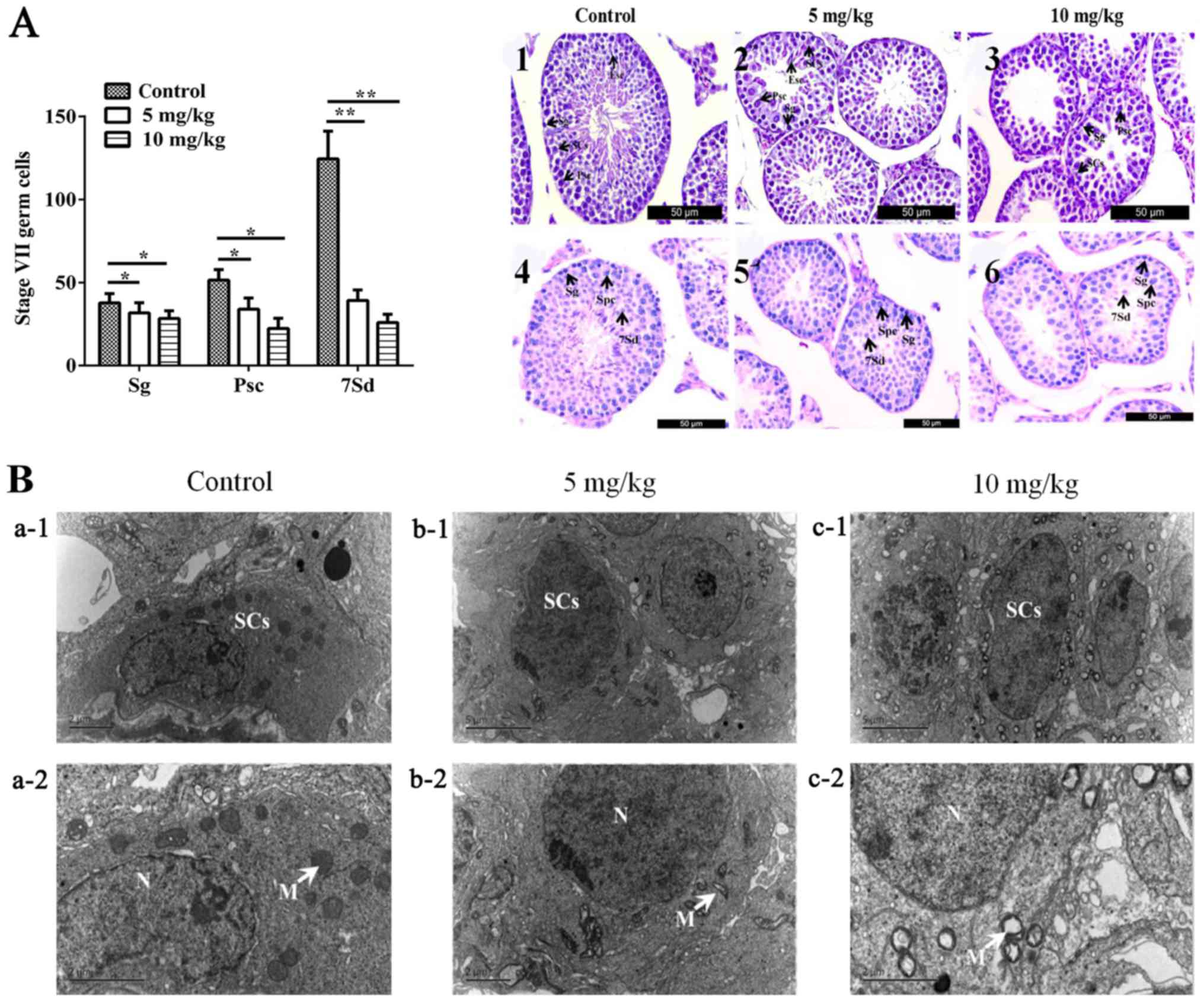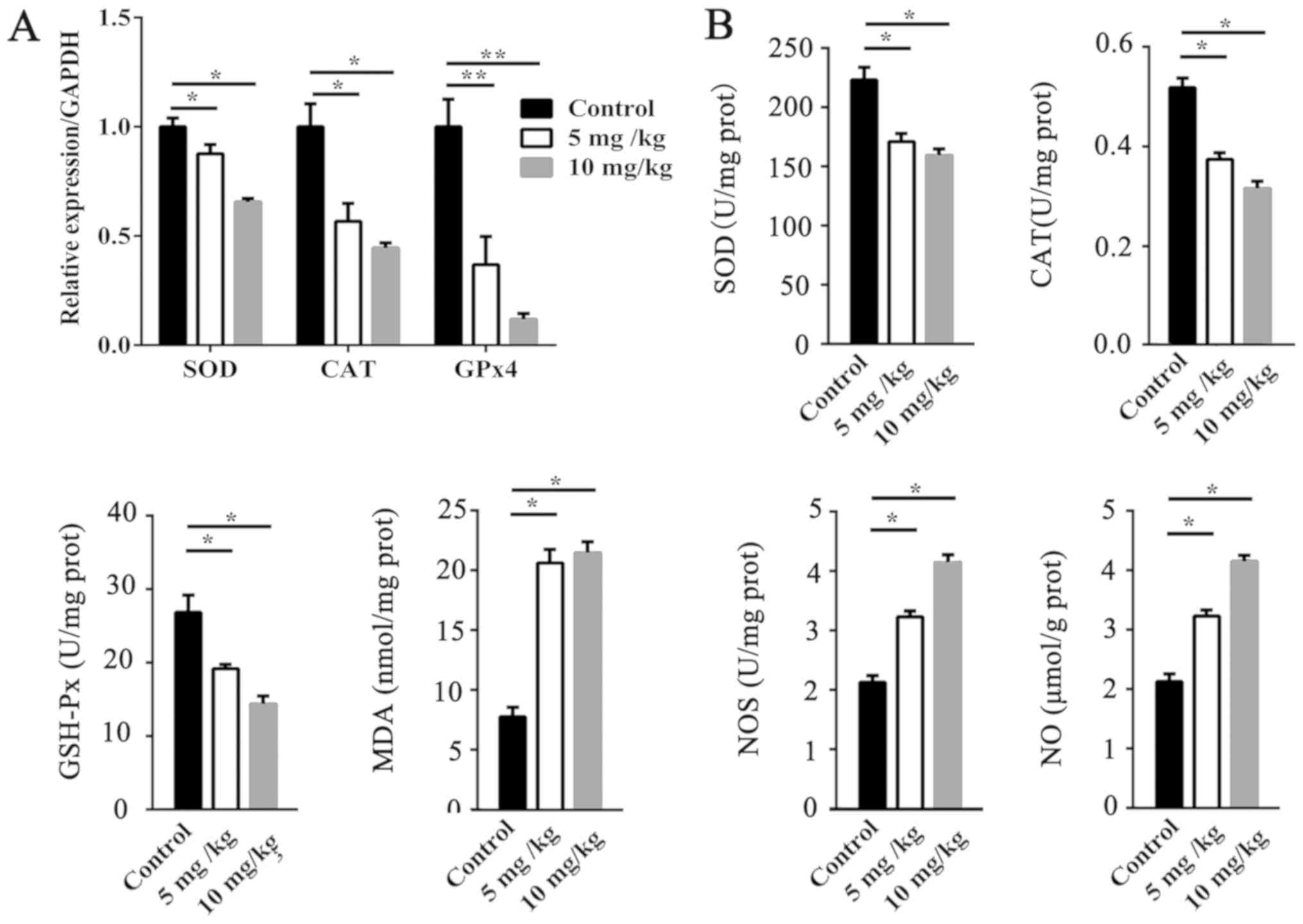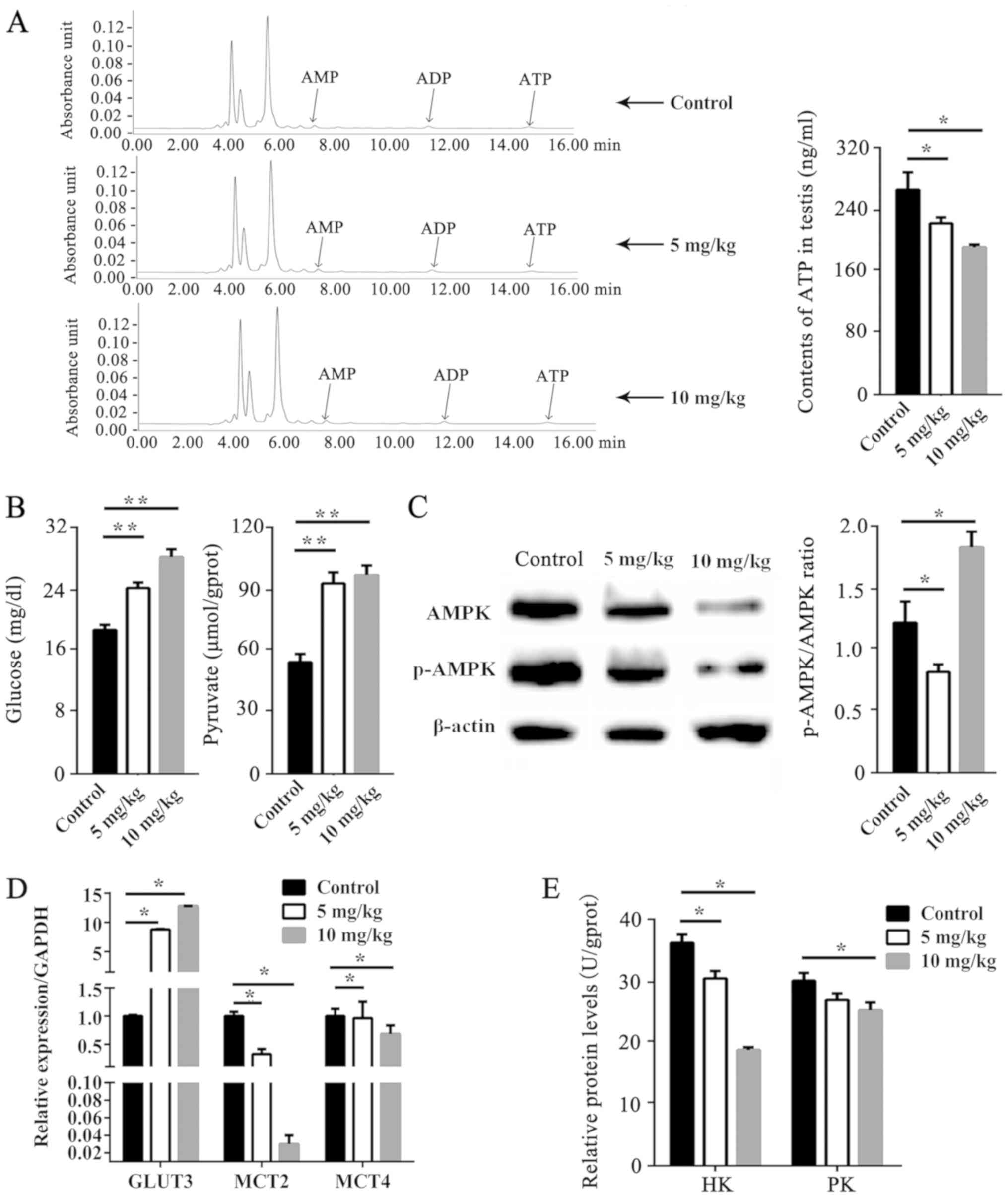|
1
|
O'Donnell L, Robertson KM, Jones ME and
Simpson ER: Estrogen and spermatogenesis. Endocr Rev. 22:289–318.
2001. View Article : Google Scholar : PubMed/NCBI
|
|
2
|
Pavlovich CP, King P, Goldstein M and
Schlegel PN: Evidence of a treatable endocrinopathy in infertile
men. J Urol. 165:837–841. 2001. View Article : Google Scholar : PubMed/NCBI
|
|
3
|
Jensen TK, Toppari J, Keiding N and
Skakkebaek NE: Do environmental estrogens contribute to the decline
in male reproductive health? Clin Chem. 41:1896–1901.
1995.PubMed/NCBI
|
|
4
|
Li X, Li H, Jia L, Li X and Rahman N:
Oestrogen action and male fertility: Experimental and clinical
findings. Cell Mol Life Sci. 72:3915–3930. 2015. View Article : Google Scholar : PubMed/NCBI
|
|
5
|
Giwercman A: Estrogens and phytoestrogens
in male infertility. Curr Opin Urol. 21:519–526. 2011. View Article : Google Scholar : PubMed/NCBI
|
|
6
|
LaRocca J, Boyajian A, Brown C, Smith SD
and Hixon M: Effects of in utero exposure to Bisphenol A or
diethylstilbestrol on the adult male reproductive system. Birth
Defects Res B Dev Reprod Toxicol. 92:526–533. 2011. View Article : Google Scholar : PubMed/NCBI
|
|
7
|
Vitku J, Sosvorova L, Chlupacova T, Hampl
R, Hill M, Sobotka V, Heracek J, Bicikova M and Starka L:
Differences in bisphenol A and estrogen levels in the plasma and
seminal plasma of men with different degrees of infertility.
Physiol Res. 64 (Suppl 2):S303–S311. 2015.PubMed/NCBI
|
|
8
|
Chaki SP, Misro MM, Gautam DK, Kaushik M,
Ghosh D and Chainy GB: Estradiol treatment induces testicular
oxidative stress and germ cell apoptosis in rats. Apoptosis.
11:1427–1437. 2006. View Article : Google Scholar : PubMed/NCBI
|
|
9
|
Walker DM, Kermath BA, Woller MJ and Gore
AC: Disruption of reproductive aging in female and male rats by
gestational exposure to estrogenic endocrine disruptors.
Endocrinology. 154:2129–2143. 2013. View Article : Google Scholar : PubMed/NCBI
|
|
10
|
Reilly MP, Weeks CD, Topper VY, Thompson
LM, Crews D and Gore AC: The effects of prenatal PCBs on adult
social behavior in rats. Horm Behav. 73:47–55. 2015. View Article : Google Scholar : PubMed/NCBI
|
|
11
|
Lei X, Cui K, Liu Q, Zhang H, Li Z, Huang
B and Shi D: Exogenous estradiol benzoate induces spermatogenesis
disorder through influencing apoptosis and oestrogen receptor
signalling pathway. Reprod Domest Anim. 51:75–84. 2016. View Article : Google Scholar : PubMed/NCBI
|
|
12
|
Cairns RA, Harris IS and Mak TW:
Regulation of cancer cell metabolism. Nat Rev Cancer. 11:85–95.
2011. View
Article : Google Scholar : PubMed/NCBI
|
|
13
|
Patnaik A, Locasale JW and Cantley LC:
Cancer cell metabolism. Springer; US: 76. pp. 299–311. 2012
|
|
14
|
Rato L, Alves MG, Socorro S, Duarte AI,
Cavaco JE and Oliveira PF: Metabolic regulation is important for
spermatogenesis. Nat Rev Urol. 9:330–338. 2012. View Article : Google Scholar : PubMed/NCBI
|
|
15
|
Oliveira PF and Alves MG: Sertoli Cell
Metabolism and Spermatogenesis. Springerbriefs in Cell Biology.
1st. Springer International Publishing; pp. 982015
|
|
16
|
Martins AD, Alves MG, Simões VL, Dias TR,
Rato L, Moreira PI, Socorro S, Cavaco JE and Oliveira PF: Control
of Sertoli cell metabolism by sex steroid hormones is mediated
through modulation in glycolysis-related transporters and enzymes.
Cell Tissue Res. 354:861–868. 2013. View Article : Google Scholar : PubMed/NCBI
|
|
17
|
Putz O, Schwartz CB, Kim S, LeBlanc GA,
Cooper RL and Prins GS: Neonatal low- and high-dose exposure to
estradiol benzoate in the male rat: I. Effects on the prostate
gland. Biol Reprod. 65:1496–505. 2001. View Article : Google Scholar : PubMed/NCBI
|
|
18
|
National Research Council (US) Institute
for Laboratory Animal Research, . Guide for the Care and Use of
Laboratory Animals. Astronomy & Astrophysics. 327:963–965.
2004.
|
|
19
|
Gouyandeh J, Modaresi M, Mansouri S and
Najafabadi FY: Long-term effects of betamethasone on epididymal
tissue, epididymal sperm counts and fertility in male mice. J Chem
Health Risks. 5:295–300. 2015.
|
|
20
|
Clermont Y and Perey B: The stages of the
cycle of the seminiferous epithelium of the rat: Practical
definitions in PA-Schiff-hematoxylin and hematoxylin-eosin stained
sections. Rev Can Biol. 16:451–462. 1957.PubMed/NCBI
|
|
21
|
Nikolaidou B, Nouris C, Lazaridis A,
Sampanis C and Doumas M: Diabetes mellitus and erectile
dysfunction. Springer International Publishing; pp. 119–128.
2015
|
|
22
|
Welborn JP, Davis MG, Ebers SD, Stodden
GR, Hayashi K, Cheatwood JL, Rao MK and MacLean JA III: Rhox8
ablation in the sertoli cells using a tissue-specific RNAi approach
results in impaired male fertility in mice. Biol Reprod. 93:82015.
View Article : Google Scholar : PubMed/NCBI
|
|
23
|
Sharpe RM: Environmental estrogens and
male infertility. Pure App Chem. 70:1685–1701. 1998. View Article : Google Scholar
|
|
24
|
Rochester JR: Bisphenol A and human
health: A review of the literature. Reprod Toxicol. 42:132–155.
2013. View Article : Google Scholar : PubMed/NCBI
|
|
25
|
Rao MV and Chinoy NJ: Effect of oestradiol
benzoate on reproductive organs and fertility in the male rat. Eur
J Obstet Gynecol Reprod Biol. 15:189–198. 1983. View Article : Google Scholar : PubMed/NCBI
|
|
26
|
Jin P, Wang X, Chang F, Bai Y, Li Y, Zhou
R and Chen L: Low dose bisphenol A impairs spermatogenesis by
suppressing reproductive hormone production and promoting germ cell
apoptosis in adult rats. J Biomed Res. 27:135–144. 2013.PubMed/NCBI
|
|
27
|
Samhan-Arias AK, Tyurina YY and Kagan VE:
Lipid antioxidants: Free radical scavenging versus regulation of
enzymatic lipid peroxidation. J Clin Biochem Nutr. 48:91–95. 2011.
View Article : Google Scholar : PubMed/NCBI
|
|
28
|
Goc Z, Szaroma W, Kapusta E and Dziubek K:
Protective effects of melatonin on the activity of SOD, CAT, GSH-Px
and GSH content in organs of mice after administration of SNP. Chin
J Physiol. 60:1–10. 2017. View Article : Google Scholar : PubMed/NCBI
|
|
29
|
Omar SS, Aly RG and Badae NM: Vitamin E
improves testicular damage in streptozocin-induced diabetic rats,
via increasing vascular endothelial growth factor and
poly(ADP-ribose) polymerase-1. Andrologia. 50:2018. View Article : Google Scholar : PubMed/NCBI
|
|
30
|
Wiktorowska-Owczarek A, Berezińska M and
Nowak JZ: PUFAs: Structures, metabolism and functions. Adv Clin Exp
Med. 24:931–941. 2015. View Article : Google Scholar : PubMed/NCBI
|
|
31
|
Schroeder F, Kier AB and Sweet WD: Role of
polyunsaturated fatty acids and lipid peroxidation in LM fibroblast
plasma membrane transbilayer structure. Arch Biochem Biophys.
276:55–64. 1990. View Article : Google Scholar : PubMed/NCBI
|
|
32
|
Sakamoto M, Ueno T, Nakamura T, Sakata R,
Hasimoto O, Torimura T and Sata M: Improvement of portal
hypertension and hepatic blood flow in cirrhotic rats by oestrogen.
Eur J Clin Invest. 35:220–225. 2015. View Article : Google Scholar
|
|
33
|
Nevzati E, Shafighi M, Bakhtian KD,
Treiber H, Fandino J and Fathi AR: Estrogen induces nitric oxide
production via nitric oxide synthase activation in endothelial
cells. Acta Neurochir Suppl. 120:141–145. 2015.PubMed/NCBI
|
|
34
|
Al-Gubory KH: Mitochondria: Omega-3 in the
route of mitochondrial reactive oxygen species. Int J Biochem Cell
Biol. 44:1569–1573. 2012. View Article : Google Scholar : PubMed/NCBI
|
|
35
|
Stepien KM, Heaton R, Rankin S, Murphy A,
Bentley J, Sexton D and Hargreaves IP: Evidence of oxidative stress
and secondary mitochondrial dysfunction in metabolic and
non-metabolic disorders. J Clin Med. 6(pii): E712017. View Article : Google Scholar : PubMed/NCBI
|
|
36
|
Liang H, Remmen HV, Frohlich V, Lechleiter
J, Richardson A and Ran Q: GSH-Px4 protects mitochondrial ATP
generation against oxidative damage. Biochem Biophys Res Commun.
356:893–898. 2007. View Article : Google Scholar : PubMed/NCBI
|
|
37
|
Ke R, Xu Q, Li C, Luo L and Huang D:
Mechanisms of AMPK in the maintenance of ATP balance during energy
metabolism. Cell Biol Int. 42:384–392. 2018. View Article : Google Scholar : PubMed/NCBI
|
|
38
|
Zhang J, Wang X, Vikash V, Ye Q, Wu D, Liu
Y and Dong W: Ros and ros-mediated cellular signaling. Oxid Med
Cell Longev. 2016:43509652016. View Article : Google Scholar : PubMed/NCBI
|
|
39
|
Kishimoto A, Ishiguro-Oonuma T, Takahashi
R, Maekawa M, Toshimori K, Watanabe M and Iwanaga T:
Immunohistochemical localization of GLUT3, MCT1, and MCT2 in the
testes of mice and rats: The use of different energy sources in
spermatogenesis. Biomed Res. 36:225–234. 2015. View Article : Google Scholar : PubMed/NCBI
|
|
40
|
D'Cruz SC, Jubendradass R and Mathur PP:
Bisphenol A induces oxidative stress and decreases levels of
insulin receptor substrate 2 and glucose transporter 8 in rat
testis. Reprod Sci. 19:163–172. 2012. View Article : Google Scholar : PubMed/NCBI
|
|
41
|
Rato L, Alves MG, Dias TR, Cavaco JE and
Oliveira PF: Testicular metabolic reprogramming in neonatal
streptozotocin-induced type 2 diabetic rats impairs glycolytic flux
and promotes glycogen synthesis. J Diabetes Res. 2015:9731422015.
View Article : Google Scholar : PubMed/NCBI
|
|
42
|
Tavares RS, Portela JMD, Sousa MI, Mota
PC, Ramalho-Santos J and Amaral S: High glucose levels affect
spermatogenesis: An in vitro approach. Reprod Fertil Dev.
29:1369–1378. 2016. View Article : Google Scholar
|
|
43
|
Oliveira PF and Alves MG: Modulation of
sertoli cell metabolism. Springer International Publishing; pp.
57–71. 2015
|
|
44
|
Oishi S: Effects of phthalic acid esters
on testicular mitochondrial functions in the rat. Arch Toxicol.
64:143–147. 1990. View Article : Google Scholar : PubMed/NCBI
|
|
45
|
Oliveira PF, Martins AD, Moreira AC, Cheng
CY and Alves MG: The warburg effect revisited-lesson from the
sertoli cell. Med Res Rev. 35:126–151. 2015. View Article : Google Scholar : PubMed/NCBI
|

















